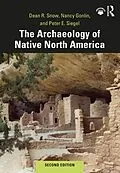The Archaeology of Native North America presents the ideas, evidence, and debates regarding the initial peopling of the continent by mobile bands of hunters and gatherers and the cultural evolution of their many lines of descent over the ensuing millennia. The emergence of farming, urban centers, and complex political organization paralleled similar developments in other world areas. With the arrival of Europeans to North America and the inevitable clashes of culture, colonizers and colonists were forever changed, which is also represented in the archaeological heritage of the continent. Unlike others, this book includes Mesoamerica and the Caribbean, thus addressing broad regional interactions and the circulation of people, things, and ideas.
This edition incorporates results of new archaeological research since the publication of the first edition a decade earlier. Fifty-four new box features highlight selected archaeological sites, which are publicly accessible gateways into the study of North American archaeology. The features were authored by specialists with direct knowledge of the sites and their broad importance. Glossaries are provided at the end of every chapter to clarify specialized terminology.
The book is directed to upper-level undergraduate and graduate students taking survey courses in American archaeology, as well as other advanced readers. It is extensively illustrated and includes citations to sources with their own robust bibliographies, leading diligent readers deeper into the professional literature. The Archaeology of Native North America is the ideal text for courses in North American archaeology.
Autorentext
Dean R. Snow is Professor Emeritus and former Head of the Department of Anthropology at The Pennsylvania State University, USA. His archaeological research interests are in Iroquoian and Algonquian ethnohistory, American historical archaeology, paleodemography, and rock art. He has conducted research projects in Mexico, northeastern North America, and Europe.
Nancy Gonlin is a Mesoamerican archaeologist who specializes in household archaeology, ritual and ideology, and archaeology of the night. She is a Professor of Anthropology at Bellevue College, Washington, USA. Her research and publications have centered on commoners in complex societies, whether working in Mexico, El Salvador, or Honduras.
Peter E. Siegel is Professor and Chair of Anthropology at Montclair State University, USA. He is a New World archaeologist with research interests in historical ecology, ethnoarchaeology, spatial analysis, and cosmological and political organization. He has conducted projects throughout eastern North America, much of the West Indies, lowland South America, and eastern Bolivia.
Klappentext
The Archaeology of Native North America presents the ideas, evidence, and debates regarding the initial peopling of the continent by mobile bands of hunters and gatherers and the cultural evolution of their many lines of descent over the ensuing millennia. The emergence of farming, urban centers, and complex political organization paralleled similar developments in other world areas. With the arrival of Europeans to North America and the inevitable clashes of culture, colonizers and colonists were forever changed, which is also represented in the archaeological heritage of the continent. Unlike others, this book includes Mesoamerica and the Caribbean, thus addressing broad regional interactions and the circulation of people, things, and ideas.
This edition incorporates results of new archaeological research since the publication of the first edition a decade earlier. Fifty-four new box features highlight selected archaeological sites, which are publicly accessible gateways into the study of North American archaeology. The features were authored by specialists with direct knowledge of the sites and their broad importance. Glossaries are provided at the end of every chapter to clarify specialized terminology.
The book is directed to upper-level undergraduate and graduate students taking survey courses in American archaeology, as well as other advanced readers. It is extensively illustrated and includes citations to sources with their own robust bibliographies, leading diligent readers deeper into the professional literature. The Archaeology of Native North America is the ideal text for courses in North American archaeology.
Inhalt
List of Figures
List of Tables
Preface
Acknowledgments
Chapter 1: Introduction
Archaeological Science
Coping with Incomplete Information
The Use and Misuse of Evidence
Mistakes and Fakes
Biological and Cultural Evolution
Basic Concepts for the Study of Cultural Evolution
Theoretical Approaches
North America and Human Potential
Calendric Conventions and Basic Terms
Oral Tradition
Art and Symbolism: Rock Art
Glossary
References
Chapter 2: Eurasian Origins
Geological Background
The Expansion of Early Humans
Environment and Adaptation
Genetic Evidence
The Evidence of Languages
The Evidence of Bones and Teeth
Demography and Conflict
Subsistence and Economy
Traveling Companions
Architecture and Technology
Resilience and Collapse
Glossary
References
Chapter 3: The Peopling of America
Environment and Adaptation
Demography and Conflict
Expansion Along the Pacific Coast
Expansion into the Interior
Architecture and Technology
Subsistence and Economy
The Great Extinction
Paleoindian Skeletal Evidence
Culture, Language, and Identity
Art and Symbolism
Resilience and Collapse
Glossary
References
Chapter 4: Archaic Cultures
Environment and Adaptation
Demography and Conflict
Managing Mobility
Subsistence and Economy
Centers of Plant Domestication
Architecture and Technology
Culture, Language, and Identity
Art and Symbolism
Resilience and Collapse
Glossary
References
Chapter 5: The Arctic and Subarctic
Arctic Environment and Adaptation
Northern Paleoindian and Paleo-Arctic
Northern Archaic and Related Adaptations
The Arctic Small Tool Tradition
Dorset, Kachemak, Norton, Choris, Ipiutak, and Old Bering Sea
Thule
Arctic Demography and Conflict
Arctic Subsistence and Economy
Arctic Architecture and Technology
Arctic Culture, Language, and Identity
Arctic Art and Symbolism
Arctic Resilience and Collapse
Subarctic Environment and Adaptation
Subarctic Demography and Conflict
Subarctic Subsistence and Economy
Subarctic Architecture and Technology
Subarctic Culture, Language, and Identity
Subarctic Art and Symbolism
Subarctic Resilience and Collapse
Glossary
References
Chapter 6: Moundbuilders of the Eastern Woodlands
Environment and Adaptation
Demography, Cooperation, and Conflict
Subsistence and Economy
Architecture and Technology
Adena Culture
Hopewell Culture
The Hopewell Trade Network
Culture, Language, and Identity
Art and Symbolism
Resilience and Collapse
Glossary
References
Chapter 7: The Mississippians
Environment and Adaptation
Demography and Conflict
Subsistence and Economy
Architecture and Technology
Culture, Language, and Identity
R…
